Rise is in many ways a very typical episode of Star Trek: Voyager.
It is an episode that certainly has an interesting premise. For all its myriad flaws, Voyager tended to have a genuine interest in playing with science-fiction concepts. At its worst, this attitude manifested itself through the various “anomaly of the week” stories that followed a familiar pattern of the ship encounter some sort of strange phenomenon with predictable results. Often this phenomenon involved time travel or interstellar dust clouds, a trend that could be traced back to early episodes like Time and Again or The Cloud.

That crashing feeling.
However, Voyager did occasionally use its interest in science-fiction storytelling to construct interesting stories. Deadlock might have set a damning precedent for the show, but it was compelling television. Blink of an Eye is a very clever little story. In true Star Trek fashion, Voyager would even use these science-fiction ideas to construct engaging allegories like the exploration of holocaust denial in Remember or the meditation on creationism in Distant Origin.
These concepts gave the series a sense of texture. They served to distinguish the show from its siblings. For example, Star Trek: Deep Space Nine was generally less interested in science-fiction high concepts than in characterisation and politics. When those sci-fi elements did show up, they were usually to torture O’Brien in episodes like Whispers, Visionary, Hard Time and Time’s Orphan. Of course, Deep Space Nine had sci-fi concept-driven stories like Playing God or One Little Ship, but they tended to stand out more from the series around them.

Up on the roof’s the only place I know…
Rise has a suitably high concept, a core idea that could easily have been lifted from the pages of the same pulp magazines that inspired The Cloud Minders. The episode is essentially a paranoid thriller unfolding within a confined space, but that confined space just happens to be a giant elevator that stretches from the surface of the planet into orbit. The premise is ridiculous, feeling like it was lifted from forties or fifties periodicals with giant insects and half-naked men on the cover. In other words, it feels of a piece with Innocence or The Thaw or Tuvix.
It is too much to argue that Rise has a brilliant concept, but it at least has an intriguing one. While it might be hard to use the basic elements of Rise to construct a classic, it should be relatively straightforward to construct a thrilling episode of television. Unfortunately, Rise simply does not work. More than that, Rise does not work for the most boring of reasons. As with a lot of Voyager, the episode is an interesting premise undercut by both a deeply flawed (and half-hearted) execution and the show’s own long-standing structural weaknesses. This happens all too often.

A dark moment for the series.
Rise is built around the idea of what might be described as a “space elevator.” Of course, the show frames it in different terms, couching that fairly straightforward descriptor in techno-babble. The word “elevator” is never spoken aloud by the characters, with Neelix referring to an “orbital tether” and “mag-lev carriages.” Nevertheless, the concept is quite simple. The episode’s visuals reinforce this notion, with the carriage and the tether quite simply a gigantic elevator connecting the surface of the planet to stations in orbit.
This “space elevator” is a very old science-fiction concept, one that connects back to the idea of “cloud cities.” In fact, the two concepts are rather tightly interwoven with one another. The image evokes the golden age of science-fiction, one quite distinct from the more sterile and restrained aesthetic of the Berman era as a whole; floating cities encased in glass connected to the surface by tethers that also serve as a point of connection the world below. These days, the image seems far more fantastical than scientific, perhaps more rooted in the aesthetic of Star Wars.
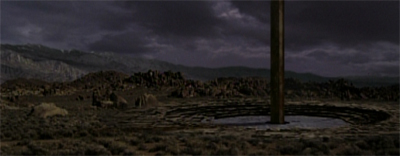
Polling suggests that it would not be possible.
The concept of these “space elevators” can be traced back to the Russian scientist Konstantin Tsiolkovsky towards the end of the nineteenth century. As Michel van Pelt outlines in Space Tethers and Space Elevators:
Tsiolkovsky visited the just-completed Eiffel Tower in Paris and started to wonder what it would take to build an elevator reaching all the way into space. In 1895 he published a book, Dreams of Earth and Sky, in which he described a giant tower extended out of the atmosphere all the way up to geostationary orbit at a height of 36,000 km (22,000 miles). On the top, at the end of a spindle-shaped cable, he envisioned a “celestial castle” (what we would now call a space station) that could be reached by an elevator. Tsiolkovsky named his system a “beanstalk”, after the giant plant from the fairy tale “Jack and the Beanstalk.” This was the first time anybody ever contemplated the concept of the space elevator, more than 110 years ago.
It is very rich and evocative imagery, even if it does not really resemble the modern concept of space travel. Even if research continues into the idea, it exists more as a “might have been” rather than as a true possibility.
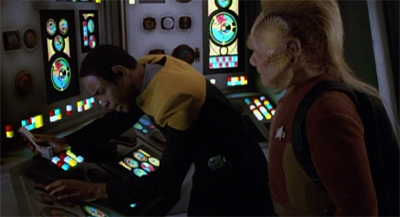
Lifting morale.
It is interesting to see Voyager playing with such a concept, but it is also very much in character for the series. Voyager feels decidedly retrograde for a Star Trek series, in both its politics and its aesthetics. For a nineties television show, it seems particularly fascinated with the dreams and nightmares of the mid-twentieth century. The Vidiians might speak to fears about AIDS, but they dress like Nazis and behave like Mengele. The Kazon reflect fears about minority communities “overthrowing” the establishment, evoking sixties anxieties.
Even the individual episodes seem to hark back to sci-fi concepts more rooted in the middle decades of the twentieth century. The show explores the morality of nuclear energy and weapons in Time and Again and Jetrel. The crew stumble across Amelia Earhart in The 37’s. Body-hopping alien threats evoke the red scare in Cathexis. The production design on Voyager might have been very sleek and modern, but the series had a decidedly old-fashioned pulpy bent to it.

“Next stop, success!”
This is especially true of the scripts written by Brannon Braga. During his early years on Voyager, Braga was heavily influenced by classic horror movie concepts. Braga’s scripts could occasionally feel like the spiritual successors to late-night monster movie marathons. Cathexis riffed on Invasion of the Body Snatchers. Macrocosm‘s oversized viruses could be seen as a tribute to the oversized insects of movies like Them! Even his story credit on Darkling felt like an homage to the horror movies of the thirties, while Cold Fire made sixties psychedelia monstrous.
Rise exists very much within that framework. It is a very silly and old-fashioned science-fiction concept, but one that appeals to Braga’s storytelling sensibilities. At the same time, the episode lacks the hooks of Braga’s more energetic or exciting scripts. Braga’s other interests tended to include particular branches of sci-fi and horror; the psychological identity crises of Frame of Mind and Projections, the repetition and duplication of Cause and Effect and Deadlock, the pseudo-evolutionary anxiety of Genesis and Threshold. In contrast, Rise feels almost generic.

“He’s dead, Neelix. Oh, wait. Wrong member of the original trio.”
To be fair, some of these other themes begin to bleed into Rise. For all that Braga was a writer interested in pulp science-fiction, he also felt very much in tune with the tone and the anxieties of the nineties. Voyager was very much a nineties television show, much more firmly rooted in the nineties zeitgeist than Deep Space Nine had been. This might explain why Deep Space Nine has aged so much better than Voyager, which feels phenomenal dated when watched even a decade after original broadcast.
Voyager repeatedly hones in on the existential crises that simmer and bubble through the nineties. The show’s fascination with time travel and the clear line that exists between the present and the future reflected the contemporary uncertainty about the end of history, the belief that forward momentum had essentially stopped and that the future was set. Similarly, Voyager’s adventures through a divided and decentralised Delta Quadrant evoked the status of the United States as the world’s lone superpower during the decade.
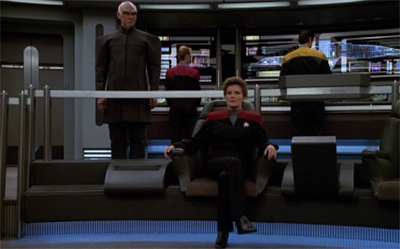
Warp nineties.
There are also very specific anxieties that play out across the series, particular in the third season. Unity and Displaced both feel anxious about the threat of globalisation in a fragmented world, whether through the forming of collectives of fragmented individuals or through the prospect of immigration from outsiders. Braga’s scripts tend to tap into similarly nineties uncertainties. The threat of viral apocalypse bubbled through Phage and Macrocosm, evoking the AIDS crisis and the ebola panic. Reality threatens to collapse in Frame of Mind or Projections.
Rise is a very paranoid and very apocalyptic episode of television. The central premise of the episode hinges on a bunch of people trapped in a confined space together struggling to trust one another. It then evolves into something of a murder mystery, as Tuvok attempts to determine who has poisoned Vatm. It is eventually revealed that Sklar is a traitor. It is heavily implied, from the fact that he can go toe-to-toe with Tuvok, that he is a member of the Etanian Order who has disguised himself as a Nezu. Trust is difficult in Rise, where nobody can be taken at their word.
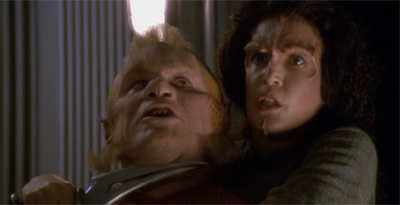
It’s a cut throat world.
Even beyond the drama unfolding within the elevator, Rise evokes other nineties uncertainties. The teaser finds a Nezu colony under attack as an asteroid races towards the surface of the planet. The closing shot of the teaser is two fragments of that asteroid hitting the surface and generating massive explosions. This is presented as an apocalyptic threat to the Nezu on the surface. Neelix and Tuvok stumble across Lillias, who has constructed her own fallout shelter. “This is my shelter. These are my supplies.”
This plays into the general tone of the nineties, the recurring dread that the end of the Cold War has not rendered survival any more likely and the looming millennium might sound the chimes of midnight for the species. After all, the asteroid imagery in Rise played into a broader cultural interest in such doomsday scenarios. The episode aired about a year before the twin releases of Armageddon and Deep Impact, two films that projected the possible end of mankind through a freak asteroid impact.

The asteroid that fell to Earth.
This reflected a very real anxiety during the nineties, perhaps reflecting the increased awareness of the asteroid impact that led to the extinction of the dinosaurs; that same asteroid impact would inspire Distant Origin later in the season. Whatever the reason, there was a recurring sense that mankind could easily be wiped out by such an impact:
”We have calculated on the basis of what we know of the Earth’s impact history that during a human life span of 66 years, there is a 1 in 5,000 chance of a major impact,” Dr. Gehrels said.
”That’s a pretty big chance, when you think about it.” But it has a good side. During the cold war, I used to hope that one of these hazardous asteroids would be spotted and that the discovery would unite America and the Soviet Union in a common effort to save the world. Even now we might see this Asteroid 1997 XF11 drawing people together.”
There is something almost nihilistic in this anxiety, in the belief that mankind somehow improbably survived the Cold War only to face extinction through a cosmic fluke. This apocalyptic dread runs through Rise, with the threat posed by the asteroid and the paranoia demonstrated by the survivors.

“We could wait for Voyager to notice that the shuttle has crashed, but that would presuppose that Voyager cares about the shuttle crashing.”
Nineties popular culture demonstrated a renewed interest in the concept of disaster movies. Part of this was undoubtedly driven by improvements in computer-rendering technology, but it also tapped into the broader mood. Movies like Twister, Dante’s Peak and Volcano seemed to suggest that the planet itself might soon turn against its inhabitants. Films like End of Days and Independence Day teased a reckoning driven by external forces that might wipe mankind off the face of the Earth.
The response to this apocalyptic dread was paranoia, itself festering and growing during the decade. Survivalism became increasingly popular, while various militias seemed to plan for the collapse of law and order. In the United States, incidents like Waco and Oklahoma City underscored the threat posed by this paranoid mindset as people like Lillias became increasingly common. As part of the same television season, The X-Files was delving into the emerging militia movement in episodes like The Field Where I Died, Tunguska, Terma and Unrequited.
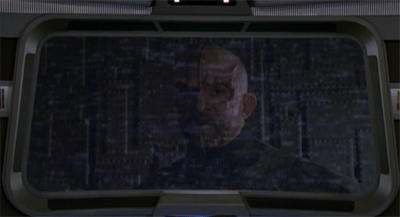
Communications breakdown.
Voyager has itself touched upon this paranoia directly. Future’s End, Part II featured a rather surreal subplot in which Chakotay and Torres found themselves captured by a bunch of paranoid militia members. “USS equals Federal Government,” insisted Porter while talking with his two captives. “The Federal Government is the Beast.” Once again, Brannon Braga frames that paranoia in apocalyptic terms, recognising that these elements are all tied together within the nineties zeitgeist.
Rise does something similar. The apocalypse facing the Nezu is framed in explicitly paranoid terms. The asteroids heading towards the planet are no coincidence, no freak of cosmic chance. Instead, the asteroids represent a weaponised apocalypse harnessed by the Etanian Order in surface of their own agenda. At one point, Chakotay cracks open a piece of asteroid to discover that it has a computer processor at its core. “Ambassador, I have a feeling these asteroids aren’t striking your planet by chance,” he reflects.

Engineered disaster.
As Marita Sturken argues in When Paranoid Male Narratives Fail, all of this is very much in keeping with the tone and mood of the culture around it:
In addition, the 1990s saw a fascination in popular culture with paranoid narratives, including such television shows as The X-Files, Dark Skies, and Millennium, the historical films of Oliver Stone, and more recent cyberfilms such as The Matrix; the continuing credence in a government cover-up of the crash of an alien spaceship in Roswell, New Mexico, in 1946; the rise of conservative and right-wing conspiracy groups in the United States; and a preoccupation with narratives of millennial apocalypse and natural disaster.
Rise is a great example of how Voyager was in tune with world around it. Voyager was very much a conservative nineties television show. That was a problem given it was meant to bring Star Trek into the twenty-first century.

Gimme shelter.
However, in spite of all these interesting elements and hooks, Rise simply does not work as an episode of television. There are a whole host of reasons for this, but they are fairly generic. Voyager has a very consistent set of problems. These problems ripple across all levels of the show, starting in the writers’ room and rippling down to the day-to-day production of the show. Watching Voyager, it frequently seems like the show never bothered to lay a competent foundation, and so even interesting stories like Fair Trade seem destined to sink into the mud.
The script problems with Rise are fairly typical of Voyager at this point in the run. Quite simple, Voyager does not have a good sense of its characters. While Rise might be anchored in a high-concept science-fiction premise and touching upon various nineties anxieties, it is also a thriller about a bunch of people locked in a confined space together. This is a very simple storytelling premise, and one that lends itself to drama. Throw a bunch of characters together and apply pressure; the result should be compelling.
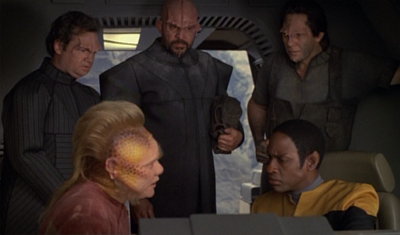
Peace in a shuttlepod.
Veteran Star Trek pitch artist Jimmy Diggs receives the story credit on Rise. According to Joseph D. Di Lella, Diggs was inspired in his pitch by the classic feature film Flight of the Phoenix:
Forgetting the major production problems for a moment, do you see the connection between Flight of the Phoenix and Rise? Separate, each doesn’t seem to have a lot in common, but the basic dilemma posed in both is exactly the same. Stranded innocents, no way out. A so-called expert comes to the rescue to save the day He turns out to be a phony, but somehow, the hero makes it all work out in the end. Jimmy simply ‘turned the screw’ and sold himself a story idea that landed him a $15,000. Plus, never ending residual checks.
Rise is many things, but it certainly does not capture the mood or tone of Flight of the Phoenix. And there is a very simple reason for that; the episode is driven by twists and turns more than rooted in characters.
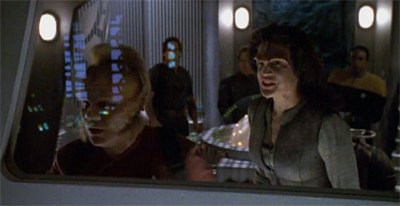
“It’s a lock.”
The script for Rise seems overstuffed with detail and plot developments. The storytelling on Voyager has always seemed driven by plot beats rather than character arcs, with writers determining how they want to tell the story and then retrofitting the characters to that. Rise takes forever to get the characters into the lift. It then heaps on a number of twists in rapid succession. Vatm is poisoned; there is vital information of the roof; Sklar is a traitor; Tuvok is thrown from the carriage.
None of these plot beats have any time to land. No time is spent looking for the murderer following the death of Vatm, because Neelix and Tuvok argue heartily about whether to go to the roof of the carriage. Once Tuvok goes to the roof of the carriage, Sklar immediately reveals himself as the traitor. There is no mystery. There is no tension. Rise refuses to play with the audience, to ask them to figure out the mystery as it goes. Instead, the episode bluntly spells everything out as if afraid that the audience might not be able to follow a simple murder mystery plot.
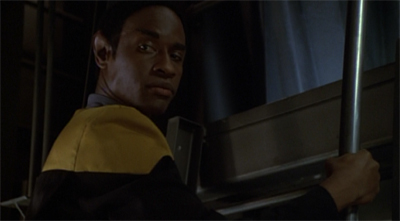
“You don’t even know what you’re looking for.”
“I’m looking for Mister Neelix’s instinct. Perhaps it will be marked.”
Oh, sick burn, Tuvok.
The plotting feels contrived, with Rise flowing very linear through the path of least resistance. Of course the information on the roof of the carriage proves absolutely essential to defeating the Etanian Order. Somehow beaming back to Voyager in the middle of a fire fight, Tuvok reports, “Captain, this data device contains tactical information about the enemy vessel, including their shield modulation.” How incredibly convenient. How exactly did Vatm come across that info? Do the Etanian Order just leave their weaknesses catalogued and lying around?
As with a number of episodes in the third season of Voyager, Rise can be compared to an episode of the fifth season of Deep Space Nine. If Looking for Par’Mach in All the Wrong Places reflected Blood Fever and The Assignment reflected Warlord, then Rise feels very much like Voyager putting its own spin on the basic plot of The Ascent. In both Rise and The Ascent, the show’s quirky comic relief and the security officer survive a shuttle crash only to have to climb to an impossible height to send out a signal of vital importance.

Pilot error.
The differences between Rise and The Ascent are informative. Most obviously, the plot of Rise feels overcrowded in comparison to the scarce simplicity of The Ascent. While The Ascent declutters the narrative to make room for Odo and Quark bickering over countless tiny things, Rise keeps adding new elements to the mix so that Neelix and Tuvok spend a minimum amount of time interacting with one another. The crash in The Ascent is just a handy way to get Odo and Quark alone together. The crash in Rise becomes part of a much larger conspiracy and invasion.
To be fair, there are even more fundamental differences. Quite simply, Tuvok and Neelix are nowhere near as well-developed as Quark and Odo. This contrast is particularly clear given that they serve similar functions on their respective shows; Neelix and Quark are the rogues who exist outside regular command structures, while Tuvok and Odo are the order-obsessed security chiefs. The fact that both Deep Space Nine and Voyager chose to pair these archetypes only invites more comparisons.

Hatching a plan.
However, Voyager quite simply lacks the teeth that define Deep Space Nine. It is unwilling to let its characters appear unlikable. As a result, Neelix is never called out for his more questionable personal decisions, such as his super creepy relationship with Kes. Repeatedly over the course of Voyager, it is suggested that Neelix is spectacularly unreliable. It is Neelix who proposed the alliance with the slavers in Alliances, it is Neelix becomes an accomplice to murder in Fair Trade.
Even in Rise, Neelix puts the entire mission in jeopardy through his exaggerations and untruths. “Mister Neelix, you told me you had experience with this kind of technology,” Tuvok reflects as the elevator rises. Neelix insists, “I did! I did! Sort of. They weren’t exactly what you might call working carriages. They were more like prototypes.” He expands, “All right, they were models. One tenth scale. But they were extremely detailed.” He insists, “They were basically identical to real mag-lev carriages. Same principles, same mechanical components.”

“One of these days I’ll bring a shuttle back from an away team.”
Neelix has just done something incredibly reckless. He has taken a bunch of people in a vehicle that he has no practical experience operating, but insisted that it was safe. Give the stakes in this situation involve a global apocalypse, that was a very dangerous gambit. Tuvok was only convinced to abandon the shuttle because Neelix claimed he could pilot the carriage. Neelix has put the entire Nezu population at risk. However, Tuvok does not hold Neelix to account for his recklessness.
This is very much a recurring problem on Voyager, a reluctance to follow basic character dynamics to their natural conclusions. Voyager is a show that favours convenience over characterisation, following the path of least resistance when it comes to details like integrating the Maquis into the crew or following Starfleet regulations. Tuvok and Neelix seem highly unlikely to ever actually get along, even if they might form a reluctant respect for one another. Again, it mirrors Quark and Odo. However, Voyager is unwilling to accept that.
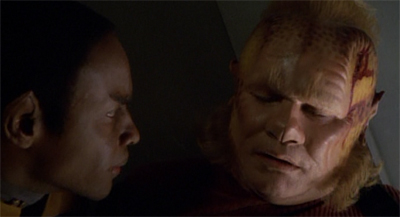
“Are you a Vulcan or a Vulcan’t?”
As a result, the characters compromise so that Rise can have a happy ending. “It’s strange, but I really like him,” Neelix confesses of his relationship with Tuvok. “I just wish the feeling were mutual.” This is understandable, but the fact remains that Tuvok is a Vulcan. Tuvok is incapable of offering the validation that Neelix so desperately seeks, just like Odo is too proud and rigid to accept the hand of friendship repeatedly offered by Quark. However, Voyager refuses to accept this fact because this might make Tuvok seem unlikable.
So Rise makes a big deal of Tuvok accepting Neelix. “Thank you, Mister Neelix,” Tuvok states at the end of the episode, offering that praise Neelix so sorely covets. “I said thank you, for opening the door.” When Neelix has a breakdown, Tuvok appeals to him in emotive terms. “Neelix, we need you.” The climax to Rise features hugging. In a tag scene, Tuvok visits Neelix and explains, “Mister Neelix, I thought you should know that I have submitted my mission report to the Captain. I’ve given you a special commendation for your endurance and bravery.”

A long bloody way to go.
The third season of Voyager has seen the series retreat into a very archetypal Star Trek template. Every episode is driven by a moral, with even pulpy stories like Darkling reaffirming the franchise’s philosophy. Rise ends with Tuvok and Neelix affirming their own philosophies. “Your instincts were correct,” Tuvok states. “However, one day your intuition will fail, and you will finally understand that logic is primary above all else. Instinct is simply another term for serendipity.” Neelix responds, “And one day, Mister Vulcan, I’ll get you to trust your gut.”
This is all very sappy and touching, but it also represents a complete betrayal of Tuvok as a character. Once again, The Ascent feels truer to the characters in question. As with Tuvok and Neelix, Odo and Quark go through a hellish life-and-death experience together. Recovering afterwards, the two take a moment to talk to one another. There is no catharsis, no commendation, no acknowledgement of approval. Instead, Odo and Quark proudly reaffirm their mutual loathing for one another, with Deep Space Nine trusting the audience to read the scene in their own way.

Hang on in there.
Of course, the mutual respect demonstrated by Tuvok and Neelix at the end of Rise would make sense if it served a larger purpose. In an interview with Cinefantastique, Tim Russ argued that it represented something of a turning point for the duo:
“Everything comes to a head in terms of our relationship, and we come back looking at it differently at the end,” said Russ. “The last scene basically reflects the way that our relationship has been, and continues along that path, but with a different understanding. His character drives a great deal of it, and I think his character also drives the exploration of the relationship.”
Not only Neelix, but the other aliens present a challenge for Tuvok. “Not everybody is the same as you, and not everybody can be expected to rise to this level and behave in the same way as you do,” said Russ of Tuvok. “That was examined and it was brought out. In situations like that he really has to deal with certain things in certain ways. He has to make realizations, make some adjustments, or try to understand other beings and the way that they are and the way they behave.”
Unfortunately, Voyager never really does anything with that “understanding.” Instead, it feels like Tuvok and Neelix revert back to their archetypal selves so that they can repeat this little dance any time that they interact with one another in a substantive way, most notably in Riddles or Homestead.
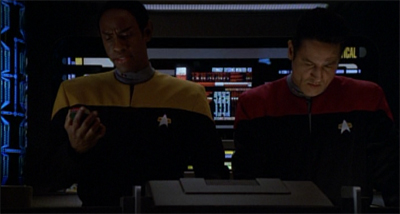
“Captain, this data device contains tactical information about the enemy vess… apologies. It appears to be Mister Vatm’s shopping list.”
Rise is also undercut by some shoddy production work. The Berman era Star Trek shows generally tend to look quite good. The computer-generated imagery in episodes like Macrocosm can be a little ropey, but generally the shows are very efficient and effective. The Berman era made a rather conscious decision to move away from the sort of stylised aesthetic that defined the original Star Trek show, save for episodes like The Thaw. This means that Star Trek is generally quite well-produced. Even if the script is terrible, there is a standard of workmanship involved.
Rise is a very poorly constructed episode of television. The direction is muddled, with Robert Scheerer often struggling to build a sense of momentum of claustrophobia on the sets. The special effects are particularly ropey, but the computer-generated tether and elevator along with more practical work. The sequence of Sklar getting sucked out the airlock is laughable, with actor Kelly Connell effectively walking backwards through the door with the footage sped up. Even beyond that, Connell turns in one of the worst performances in the franchise history.
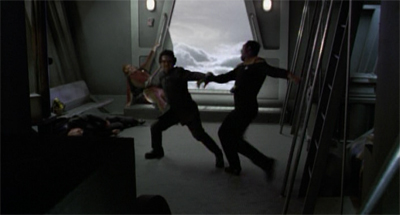
“Boy, this sucks.”
The result is an episode with a potentially interesting premise that is deeply flawed in a number of ways that are par for the course of Voyager. This is a show that seems to be struggling to rise to meet expectations, alone surpassing them.
You might be interested in our other reviews from the third season of Star Trek: Voyager:
- Basics, Part II
- Flashback
- The Chute
- The Swarm
- False Profits
- Remember
- Sacred Ground
- Future’s End, Part I
- Future’s End, Part II
- Warlord
- The Q and the Grey
- Macrocosm
- Fair Trade
- Alter Ego
- Coda
- Blood Fever
- Unity
- Darkling
- Rise
- Favourite Son
- Before and After
- Real Life
- Distant Origin
- Displaced
- Worst Case Scenario
- Scorpion, Part I
Filed under: Voyager | Tagged: Brannon Braga, neelix, rise, star trek, star trek: voyager |




















“Blink of an Eye is a very clever little story.” What do you think about the allegation that it plagerized the story, Dragon’s Egg? I have not read the story, but the reviewer Sfdebris made a fairly compelling case.
The third season of Voyager marked an increase in the use of CGI, and I thought this led to the shows being more variable in special effects quality. Whenever the ships are in space, it is usually ok, but any shot on a planet tended to look pretty bad, such as this episode.
Well, to be fair, there are very few truly original ideas in science-fiction. Although I’ll admit to never having read Dragon’s Egg, either.
Interesting review of an episode I have no memory of.
I’m fascinated by your notes about Nineties TV. It seems surreal to look back now that so much popular culture of the time was paranoid and insecure when from nearly every objective standpoint the decade was one of huge prosperity and tranquility (I remember that link you gave that pointed out serial killings were already dropping fast from the 1990s.) It wasn’t just genre shows either; I was a teen in the 90s and vividly remember shows like Daria.
Ha! Glad to see that it made an impression! It sticks in my memory, if only because “space lift” is such a ridiculous fifties sci-fi concept that I can’t get over not loving the episode.
Yeah, and in hindsight the nineties were a very strange time.
In a season filled with dull rehashes of DS9’s far superior fifth season, Rise may be the most blatant example yet of Voyager’s total lack of imagination. The similarities between Rise and The Ascent are depressingly familiar that you’ve mentioned most of them already Darren. I suppose the Etanian Order is the VGR equivalent of DS9’s Orion Syndicate or the Obsidian Order. Take your pick. And in both episodes something is hidden away from the characters (the bomb on Quark and Odo’s Runabout and the tactical data PADD on the carriage) that proves vital to they’re survival.
But like most of these rehashes we’ve seen this year, Rise never really does what The Ascent did so much better, and that is to explore the simmering resentments between the two actors carrying it. Having so many (disinteresting) characters in the carriage dilutes it and takes much of the focus away from Tuvok and Neelix, whereas Quark and Odo were put front and centre, trapped in the company of one another.
I don’t like stories where a character’s only purpose is to be proven wrong like Tuvok’s grudging discovery of the data PADD. Odo was much more amenable to Quark’s instincts about the bomb and that was over and done with in just a few minutes. Tuvok has to be practically strongarmed into going to the roof so the episode can prove Neelix is right all along and make Tuvok seem all the more foolish. Rise straddles the themes of a pressure-cooker situation and two frenemies forced together by circumstance to survive. It achieves neither.
Yeah. I’m fonder of the third season of Voyager than most, in large part because I really like a few episodes that most fans are indifferent to and in part because I just like the weirdness of it, but rewatching it alongside Deep Space Nine’s fifth season just underscores everything that made Deep Space Nine great and everything which made Voyager mediocre.
And that is exactly what Tuvok and Neelix are…mediocre. Whereas Quark and Odo are not. They enliven any scene just by being together. Scenes like that with Tuvok and Neelix – you could count them on one hand (or one digit?).